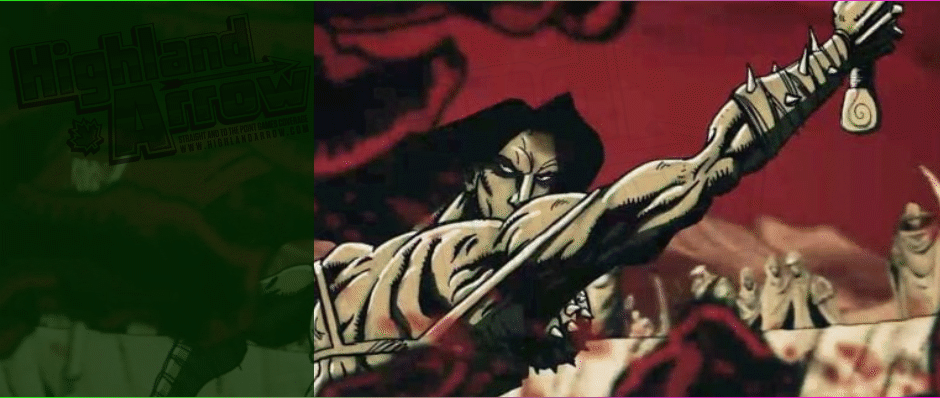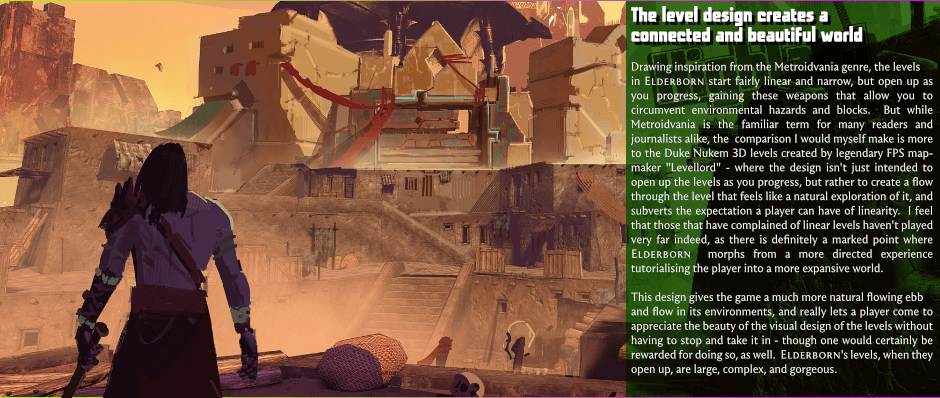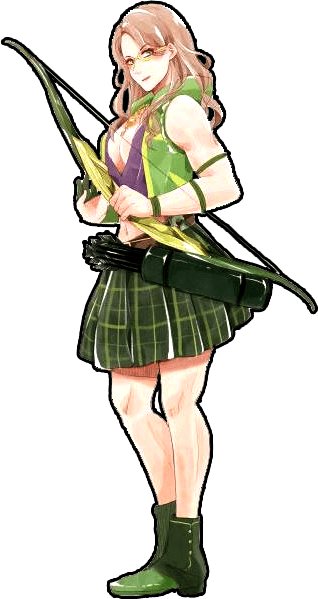

Elderborn
Platforms: PC
Reviewed on: PC
Reviewer: Maiyannah Bishop
Review Play-Time: 5h
Developer: Hyperstrange
Publisher: Hyperstrange
Released: 2020-01-30
Review Published: 2021-12-24
+ Melee combat feels fluid and visceral
+ Wide selection of enemies and weapons
+ Excellent level design that opens open as
you progress
- Interface clumsy with mouse & keyboard
- Weapon variety becomes burdensome
- Awful voice acting

Elderborn is a first-person melee-focused “shooter” game borrowing heavily from elements of the Metroidvania and “Soulslike” games, developed and published by Hyperstrange. This one came kind of out of left field for me when I first looked at it, and I have to admit: I played it for a small time, decided it was an alright time but wasn't really taken in by it, so I left it to come back to later. Well later ended up considerably later, but here we are, and I have to say, while it is not perfect, Elderborn is probably the best implementation of this kind of first-person melee-focused game I've seen, and I've played a few. Elderborn represents a very stylish- and kinetic-feeling experience that manages to be a lot of fun, even amidst its missteps, but that fun wanes as they build up, in the latter half.
Elderborn places you in the sandals of a barbarian warrior - starting with the ability to choose a male or female player character, and at which difficulty you will play - of which there are four: ranging from “Normal” to “Hard AF”. The developers are not winning any points for originality there, but they're also not joking in the name: Elderborn is excessively challenging on the highest setting, being essentially the game's “Nightmare” mode - it isn't even trying to be fair. For the record, my own playthrough was completed on the third option, which still was significantly challenging, and especially with the bosses I got my arse handed to me more than once. "Normal" in comparison is a breeze if you understand the mechanics, so in practical terms, it can be considered the easy mode. Indeed the challenge is well-graduated: each of the levels gives the impression of an appreciable increase over the other. This is not some STALKER silliness where it is actually more advisable to go on the harder setting or anything such as that.
I believe I should note, for those that look for this sort of thing, that “male” or “female” choices are the entire breadth and depth of any character appearance modification. I don't particularly feel that it detracts from the experience, but some people do look for that and want said personalisation, and, well: you won't find it here. Honestly, this is all in first person with the only appearance otherwise of the protagonist being in the concept-art-gallery style of cutscenes, so it would be ill-placed if it was included, in my opinion. Regardless of personal opinions however, that character creation system is not there if you were looking for it. Further customisation of the character takes place entirely through advancing attributes - which we will touch on a little further in.
The Call of Jurmum
You begin at the bottom of tombs underneath the city, tasked with foiling the city's great scheme or whatever - I have to be honest, the dull, droning voice-over of the female protagonist over the cutscenes explaining the premise had me mentally check out very quickly, so I couldn't truthfully claim I followed the plot that was presented in the cutscenes. And while I'll talk about the rest of the sound later, this is an immediate low point - well, more akin to the bottom of a chasm - in it. The voice actress has no emotion, inflection, or even variation in the delivery, resulting in cutscenes that are a monotone, droning narration that even when I was trying to pay attention, I simply didn't retain at all. Writing this now, I couldn't relate to you the intro cutscene without going back to watch it again, for instance. I did manage to pick up the better parts of the story through that storytelling present in the environment - and indeed, that represents probably the better weight of narrative in the game, between that and the boss encounters. In fact, I would go so far as to double-down on that: one would be perfectly-fine with the environmental story-telling alone; which does somewhat beg the question of why they included the cutscenes when the voice-acting is such poor quality. Well, to be flashy and draw people in, of course, but this smacks somewhat of trying to sell the thing when I've already bought it.
On the topic of marketing, a lot of the initial traction this game received was from it being another entry in the ever-growing catalog of “souls-like” games, and that is not a comparison completely without merit, as some of the central advancement mechanics are at the very least “inspired” if they are not lifted from Dark Souls whole-cloth. You start with three healing phials, and using one of a variety of convinently-spaced healing fountains refills them as well as your health, when you use them. Much akin to the bonfires from its predecessor, doing so respawns all the enemies, and refills your vials. Additionally, you can only level up at one of these places. To be precise though, you do not need to use the fountain to level up - just be in the proximity of one; it's usually optimal to do so, though, as you'll gain more experience to push you further in advancement by doing so, however.
To call it a complete lift is not warranted, however: Elderborn differs from Dark Souls in a very specific way that changes that core component of the mechanical critical path. Where Dark Souls only allowed you to refill the Estus Flasks and their various counterparts in the other competitors at the resting-points, Elderborn slowly refills the health gems with each kill, allowing for a markedly more aggressive and fast-paced gameplay style. One of my big personal criticisms of Dark Souls - a series I probably will eventually get to writing retrospective reviews on at some point - is that progress can slow to an absolute crawl if you are under-powered for a given segment and needs slowly grind your way up. Having the healing recovery items slowly be increased as you defeat your opposition, allows the player a much faster general clip of progression, and it mitigates the more difficult sections, in turn making the gameplay much less of a slog. All in all, I find it a solid improvement, and more on point, a considerable difference from the competition it emulates with these designs.
The Blade is Drawn
The other major deviation from Dark Souls in terms of the progression is that of character development: whereas Dark Souls has a class-based and intricate progression which is more item-focussed, the advancement of Elderborn is a simplistic progression of three basic attributes. You have three, and each one translates to simple benefits: Might is the pure damage of attacks and your handful of skills, speed is movement and attack speed, and Resilience is basically your amount of hit points. Each gives you a few active skills and several passive bonuses for progressing them, but other than that, I found them unmemorable. I could not recall what the active skills were without going back into the game to look it up, which is a fact that in its mere existence communicates how impactful anything but the raw increase of damage, speed, and endurance mattered to the overall combat.
The active abilities you do get across the progression aren't too much to write home about, to be honest. The one you'll actually use a fair bit is a short-ranged dodge or sidestep that let you be much more mobile with your combat even in its lowest level version, and I find a lot of the complaints of unfairness come from those who haven't come to grips with the evasion mechanic. I actually kind of don't get this: I must admit my mobility impairment can make me all thumbs with something such as the finer points of parry of block systems in a lot of these systems, but in Elderborn's case, it is snappy and responsive, so the only real problem is ranging it, but given that the feedback is good and immediate, that's something you can work out with a little practice. In my opinion, I do not think it is on the developers in that case. However, the flip side of this is that the skill ceiling of the ability seems very low as well, so proficiency with this ability becomes very binary: you “get it” or you don't - without much seeming to be possible in the way of optimization for it, other than positioning. This makes something that is usually a big deal sound as if it is not one - and in this case, that would be correct, because it isn't. We'll touch more on the map design later, but it is very twisty-turny passages that only occasionally give you enough room that positioning becomes a huge factor. The potential to fall to your death tends to limit one's willingness to experiment, after all! As to the other abilities, I used them so rarely I honestly couldn't recall now as I'm writing, which should tell you how much of a factor they became in my gameplay.
That's not to say what is there is bad: the combat, at least at first, appears very stylish, fluid, and it possesses a momentum that only grinds down in the later game. The combat mechanics themselves, in my opinion, are the best I have seen at the time of writing, at least in the first-person perspective: the weapon hits are very visceral and impactful; the distances at which weapons connect with targets or yourself feel true and correct, so you are not wiffing things that you think should have hit, or dodging things and getting hit anyways, as can often happen; and the short dash/dodge you do have in the abilities list is intuitive enough that you have a lot of mobility in the combat. Mechanically, you have a system that if it was any tighter, one would be in danger of suffocation, and it manages to have a low skill floor and high skill ceiling, which is to say in less pretentious terms: it truly is “easy to learn, hard to master.” That's not to say it is perfect: there are a few clipping issues I had with things not quite colliding as they should, and there were a few infrequent bugs like that. In one particularly egregious instance I tried to jump over an enemy with a lunge attack and ended up bouncing off them at such a trajectory and angle I was projected out of the world, at probably world-record-breaking speeds; which, unsurprisingly, killed me. Those bugs never detracted from the game enough for me to stop having fun with the combat though, and let me tell you, the kick ability to literally punt critters off ledges never got old. Never.
Vertigo
Where Elderborn falls apart with weapon selection, is in what I call the “chainsaw problem”. What is the chainsaw problem? You have a weapon that changes what is in that binding slot, that is considered to be an upgrade, but more like a sidegrade at best, which, in turn, causes it you to have to constantly switch from the 'default' side-grade weapon to the more desirable original one. I take this terminology from the original Doom and Doom 2, where the chainsaw is actually less desirable than the fists in the higher difficulty modes if you have the Beserk Pack power-up, so if you have a chainsaw, you constantly have to switch to the chainsaw and then to the fists, every time you change over from a gun. In Elderborn, you have a great variety of weapons: a sword, a spear for less damage but greater reach, the hammer which breaks through terrain obstacles and enemy blocks, the sickles which attack very quickly, and the Sword of Janus, which is a big chonkster of a sword which has a wide, sweeping arc meant for crowd control. Most of these weapons have a side-grade replacement - perhaps all of them do and I simply missed some of them. The worst example of the aforementioned issue is in that of the katars, which are meant to be a weapon where you get increasing damage combos if you keep hitting the same enemy in succession. In theory, this makes them ideal for the bosses, or so one would think - quickly one realizes that since there is a “time out” on that effect, and all of the bosses have mechanics which you need to dodge, weave, and evade to resolve, then it quickly becomes apparent that the moderate damage of the quick scythes that the katars replace, is more desirable than a weapon that starts weaker, but becomes more damaging with successive hits. In most cases, your DPS is going to be lower using the katars compared to the sickles, unless you are extremely precise and quick about resolving the mechanics. Even then, in checking other player's footage to gut-check my own experience and observations of the two weapons, most players I watched preferred the scythes over the katars; yet, since the katars are in the slot first, you would basically end up having to switch twice to get the weapon you actually desired. While you can train the muscle memory around this double-switch necessity of the interface, it was a constant annoyance throughout gameplay. There are other less egregious examples: the side-grade spear weapon called the “Golden Spear” changes the block to a less easy-to-use block for the 'benefit' of kills dropping more essence (though it wasn't enough to feel worth it), and the specialized “Golden Cleaver” replacement for the Sword of Janus which is huge damage … but you cannot heal while wielding it, making any use of it require Doom Eternal style fast weapon-switching - and not wanting to give myself carpal-tunnel syndrome, I avoided it. Indeed, in subsequent playthroughs for getting screenshots and double-checking things, I avoided picking up many of the secondary weapons altogether.
There are a variety of enemies to smack with your preferred weapon(s) of choice from the above, which go into a few groups: a variety of undead, “drowners” with leaping attacks, scorpions, Golden Army Soldiers, bandits, and a few other varieties I am doubtless forgetting. Each enemy type breaks down into a few specific sub-classes: for example, the undead have a standard zombie, a skeleton with javelins for ranged attacks, a sword and shield skeleton that more or less acts as a tank for the others, and to obstruct your free movement. Many of the enemy types are inventive and have different silhouettes - which makes them easy to identify in a crowd: the different armaments of the undead, or the Golden Army soldiers, for instance, makes them easily recognizable. There is one notable exception to this rule: the scorpions are mostly distinguished by size and colour - there's a normal red one, a yellow one that has more health, and a bigger red one that, essentially, needs killed twice: it'll come back after a short period. There's enough variety in what the different enemies do to keep it fresh, but not so much that it's overwhelming; I felt that Elderborn found a good balance here. I do have to confess being lukewarm on that point, but we'll come back to that.
Towers of Jarmum

One thing which stood out to me particularly was how each level dynamically opened up as well, through the game play - there was a feeling that progression in each area was not only broadening the level per se, but also having an effect on the game world. For example, in one level you "power up" several towers - lampshaded by the soundtrack title that I grabbed this section's heading from - and this not only opens up the area as you can progress to each tower in turn, but also changes the city, lights emit, more (hostile) people come around, and there's a likewise feeling that to progress, you're basically waking the slumbering giant that is the Golden Army entombed in that city. The traps also help both make the place alive - as they make sense diagetically - and also help flag the areas you've been through if you are backtracking, since most only trigger the once. There's also a considerable amount of environmental cues used well: a great one which comes to mind is the lighting in the area for a key of a certain colour, matching that key's colour. These kinds of things aren't the subtlest way to direct the player around a level, I will confess, but the transversal thereof is not the challenge of the game, and the design here has focussed on the combat; a focus I support and think is the best course here.
To circle back, the opposition that populates these levels feature a very neat flourish of visual design to tell their health without visible health bars or anything like that: the undead, from the standard normal zombies, to the rolly mummies, to the armoured ones, all have “strange glowing maggots” (as the lore entry calls them) that cover them, which, as you damage these creatures, start to fall off in number, until they are dead. Or … more dead, they are skeletons and zombies and such after all. Likewise, the lava scorpions in all their coloured varieties have colourful markings that will dim and diminish until they dinally die, and the magic arms of the Golden Army will become duller as they are further and further pressed. Each enemy has a visible, diagetic way to tell their health, which is an interesting and not-often-seen bit of immersion in such a game.
In essence, there are five types of enemies: undead, corrupted humans, the various scorpions, bandits, and the Golden Army soldiers. Each of them have a few subsets, though to be honest, with the exception of the corrupted humans, they can be typed into standard varieties: a standard melee unit, a hardened melee unit that requires either a parry or block-break (or clever maneouvering), and a ranged unit. Corrupted humans are the enemy type that seems to get away from that, with the leapers that try to drown you in water, and lepers that will try to lunge and flank you requiring much more mobile combat than the positioning dance, since they will aggressively press the action. I'm a bit on the fence on the enemy variety, to be forthright: I would have preferred more mechanical differences between the different ones, but this also is one of the pain points of indie game thrift, and there certainly is enough here.
Point of No Return
There's one thing that really stops me from giving this game an editor's choice stamp, or otherwise give it more glowing praise, and honestly it isn't the voice-acting, terrible as it is, or some lack of diversity in mechanical or enemy design. No, the chink in this games armour is the interface design and controls. That's not to say they are terrible, but they lay a constant low-key sort of pull on the general quality of the game. This wades into territory both myself and my readers are probably familiar with: this is a game obviously designed for console controllers, and it shows. An obvious example exists in the whole “press and hold” thing from console - and with the keyboard and mouse as controllers this feels needless and obtrusive, and often clumsily impedes the game flow. Likewise, the weapon-switching with q uses a wheel clearly meant for an analog stick, and perhaps I'm just rubbing up against my mobility impairment here, but it does not work well on the mouse and keyboard - especially in the heat of combat in a system which really wants you to switch between different weapons to select the ideal one for any given situation. So, in short: if you use a controller, you'll probably be alright, but if you use the PC's native controller: a mouse and keyboard, you're shortchanged by this game.


